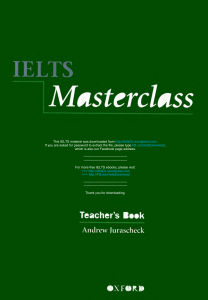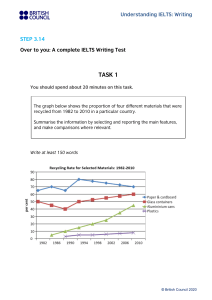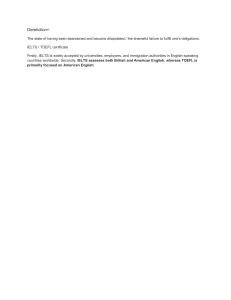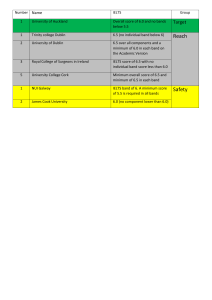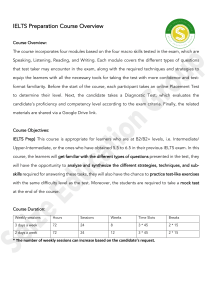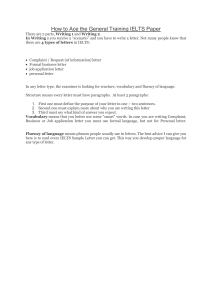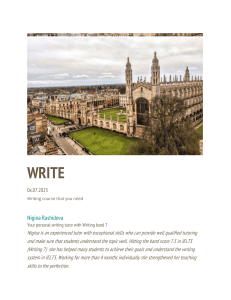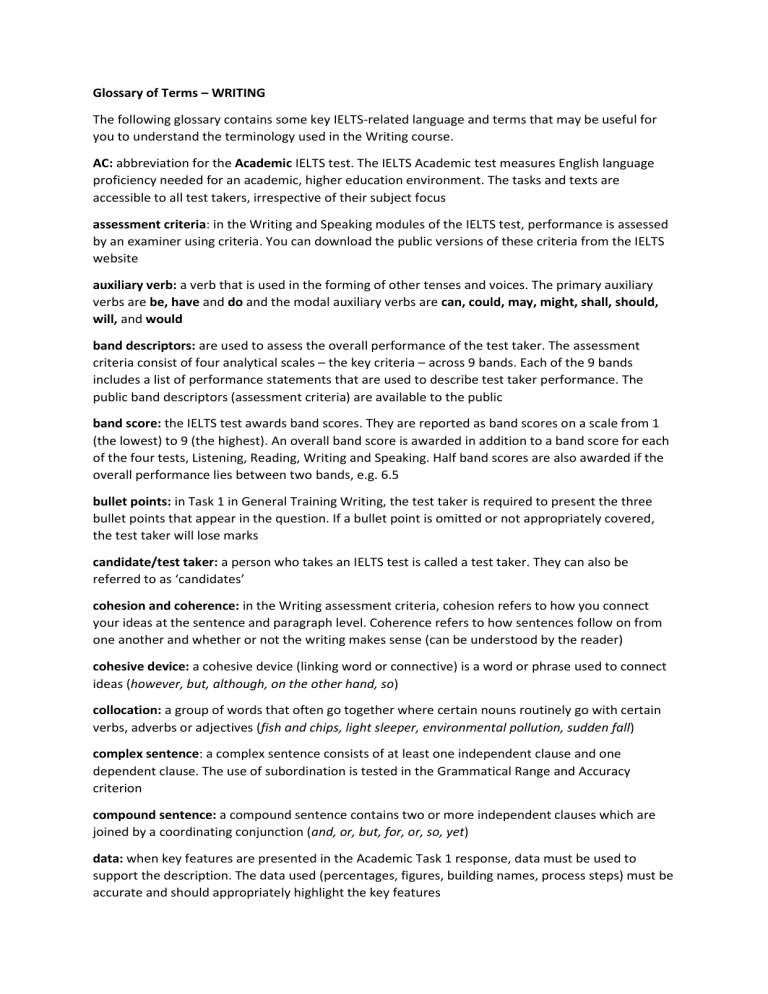
Glossary of Terms – WRITING The following glossary contains some key IELTS-related language and terms that may be useful for you to understand the terminology used in the Writing course. AC: abbreviation for the Academic IELTS test. The IELTS Academic test measures English language proficiency needed for an academic, higher education environment. The tasks and texts are accessible to all test takers, irrespective of their subject focus assessment criteria: in the Writing and Speaking modules of the IELTS test, performance is assessed by an examiner using criteria. You can download the public versions of these criteria from the IELTS website auxiliary verb: a verb that is used in the forming of other tenses and voices. The primary auxiliary verbs are be, have and do and the modal auxiliary verbs are can, could, may, might, shall, should, will, and would band descriptors: are used to assess the overall performance of the test taker. The assessment criteria consist of four analytical scales – the key criteria – across 9 bands. Each of the 9 bands includes a list of performance statements that are used to describe test taker performance. The public band descriptors (assessment criteria) are available to the public band score: the IELTS test awards band scores. They are reported as band scores on a scale from 1 (the lowest) to 9 (the highest). An overall band score is awarded in addition to a band score for each of the four tests, Listening, Reading, Writing and Speaking. Half band scores are also awarded if the overall performance lies between two bands, e.g. 6.5 bullet points: in Task 1 in General Training Writing, the test taker is required to present the three bullet points that appear in the question. If a bullet point is omitted or not appropriately covered, the test taker will lose marks candidate/test taker: a person who takes an IELTS test is called a test taker. They can also be referred to as ‘candidates’ cohesion and coherence: in the Writing assessment criteria, cohesion refers to how you connect your ideas at the sentence and paragraph level. Coherence refers to how sentences follow on from one another and whether or not the writing makes sense (can be understood by the reader) cohesive device: a cohesive device (linking word or connective) is a word or phrase used to connect ideas (however, but, although, on the other hand, so) collocation: a group of words that often go together where certain nouns routinely go with certain verbs, adverbs or adjectives (fish and chips, light sleeper, environmental pollution, sudden fall) complex sentence: a complex sentence consists of at least one independent clause and one dependent clause. The use of subordination is tested in the Grammatical Range and Accuracy criterion compound sentence: a compound sentence contains two or more independent clauses which are joined by a coordinating conjunction (and, or, but, for, or, so, yet) data: when key features are presented in the Academic Task 1 response, data must be used to support the description. The data used (percentages, figures, building names, process steps) must be accurate and should appropriately highlight the key features essay: a piece of writing that is written in response to a prompt, or question. It generally contains a point of view and an argument consisting of information or ideas relevant to the essay topic. It is organised into paragraphs, with an introduction, a body, and a conclusion examiner: in the IELTS test, an examiner assesses Writing and Speaking tests format: IELTS Writing responses need to be written in the correct format. The essay in Task 2 should consist of paragraphs and should not contain headings, sub-headings, dot points or a list of numbered ideas. For Task 1 AC, the same applies. It should not be written in note form. For Task 1 GT, the response needs to be written in ‘letter’ format, with appropriate opening and closing conventions GT: abbreviation for the General Training IELTS test. The IELTS General Training test measures English language proficiency in a practical, everyday context. The tasks and texts reflect both workplace and social situations IELTS: International English Language Testing System, a globally-recognised test of English language proficiency. There are two types of test, Academic (AC) and General Training (GT) indicative band score: an indicative band score is awarded in the online practice test based on the public band descriptors key criteria: In each of the 9 bands there is a list of performance statements. These describe test taker performance for a set of key indicators linked to the key criterion. Each band has a set of key criteria. For example, for Fluency and Coherence, the key indicators of performance are: speech rate, the use of pauses and hesitations, the use of linking devices and discourse markers, and how much topic development occurs key features: in Writing Task 1, the response must present all key features that appear in the visual. Key features are the main features presented, for example, countries, products, unemployment figures in three different years, the seven stages of a process. They also include unusual spikes or drops in statistics, or other unusual (key) features less common lexical items: vocabulary used by the test taker that is less common. For example, the use of idiomatic language, phrasal verbs and collocation lexical resource: the range of words or vocabulary a person uses in order to communicate in English lexis: the words or vocabulary used by the test taker modality: the use of modal verbs to express certainty, probability and possibility. These modal verbs include must, shall, will, should, would, can, could, may and might module: the IELTS test is divided into four sections for Listening, Reading, Speaking and Writing nominalisation: where the writer changes the verb (actions and/or events) into a noun phrase (concepts, things or people). For example, ‘Unemployment is increasing rapidly…’ – ‘The rapid increase of unemployment…’ online practice test: an online practice test (IELTS Progress Check) has been developed by the IELTS partners, where test takers can check their progress in preparation for the real IELTS test overall band score: a score is given for each test component – Listening, Reading, Writing and Speaking. These individual scores are then averaged to produce an overall band score overview: an overview is presented in Task 1 to summarise the main trends and features seen in the visual. It acts as a summary paraphrase: the use of different words and phrases to explain what you are trying to say if you cannot find the right words. In the Writing test, test takers paraphrase the question, so they are not directly copying from the question stem passive voice: is used when the subject of the sentence is acted on by the verb. It is formed by using the verb be + the past participle Active voice – The dog bit the man Passive voice – The man was bitten by the dog prompt: a writing prompt is the question given to a test taker in the IELTS test. The prompt includes the question and the instructions. Writing prompts often contain more than one part purpose: the purpose of a letter is the reason for writing the letter to the other person. It could be a letter of complaint, a letter offering suggestions, or a letter sent to invite a friend to a wedding referencing: helps with text cohesion and is used to avoid repetition by using pronouns in place of nouns section: the IELTS Listening test has four sections, and the IELTS Reading test has three sections simple sentence: a simple sentence is a stand-alone sentence consisting of an independent clause style: style refers to how formal or informal our language choices are. It depends on the audience we are speaking or writing for subordination: a complex sentence consists of an independent and dependant clause. The dependant clause is the subordinate clause and usually contains a subordinating conjunction (because, although, once, since, when, while, as) syntax: how words and phrases are arranged in a sentence following grammatical rules (for example, subject + verb + object) systematic error: occurs when a test taker repeatedly makes the same grammatical error. For example, article errors, subject/verb agreement errors. If the errors are occasional and do not show a pattern, then they are classified as non-systematic errors tangential: in IELTS Writing, if a response is on-topic but off-task, it is said to be tangential to the prompt task: in IELTS Writing, there are two tasks, Task 1 and Task 2 (discursive essay). The Academic test requires you to write a report in Task 1 and in the General Training test, you are required to write a letter task achievement: the criterion used to assess how appropriately, accurately and relevantly a test taker completes Task 1 of the Writing test task response: the criterion used to assess how well a test taker can present and develop an argument and support a position in Task 2 of the Writing test tense: refers to which form of the verb is used to show when an action happened. Common verb tenses include present, past, and continuous tenses TESOL: Teaching English to Speakers of Other Languages tone: when a letter is written in the General Training Writing Test, the tone needs to match the question prompt instructions. The letter should be written in a formal/neutral tone if written to ‘Dear Sir/Madam’ and in an informal/friendly tone if written to a friend or colleague ‘Dear john’ visuals: a visual representation used for Task 1 Academic. For example, a graph, a diagram, map or process word form error: occurs when a test taker chooses the right word but uses the wrong part of speech. For example, ‘I am very happiness.’ – noun chosen instead of the adjective Writing Assessment Criteria: the version of the Writing band descriptors that are available to the public Source: www.ielts.org https://www.ieltsessentials.com/global/ieltshome IELTS Scores Guide
